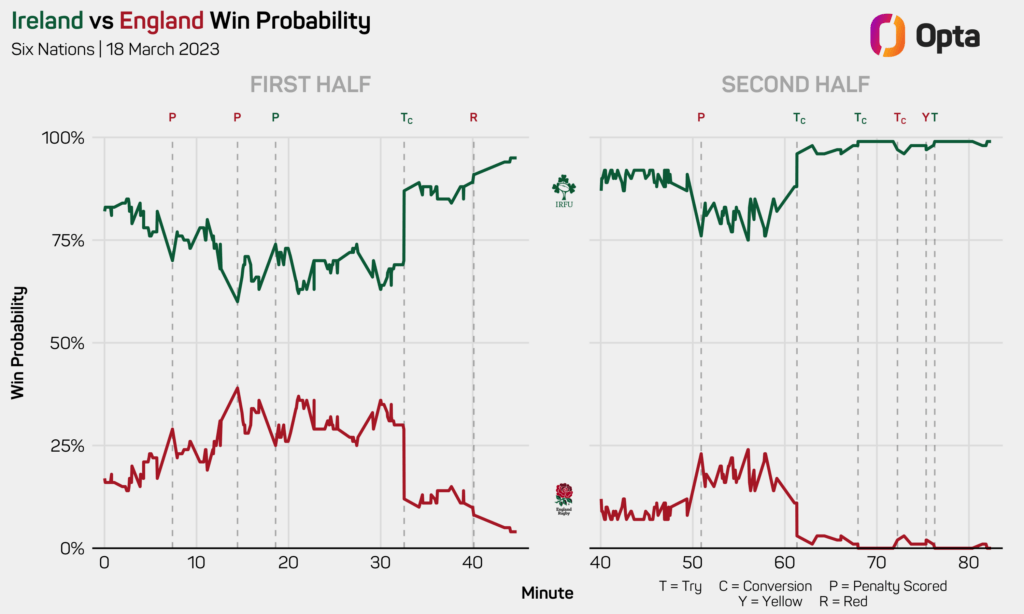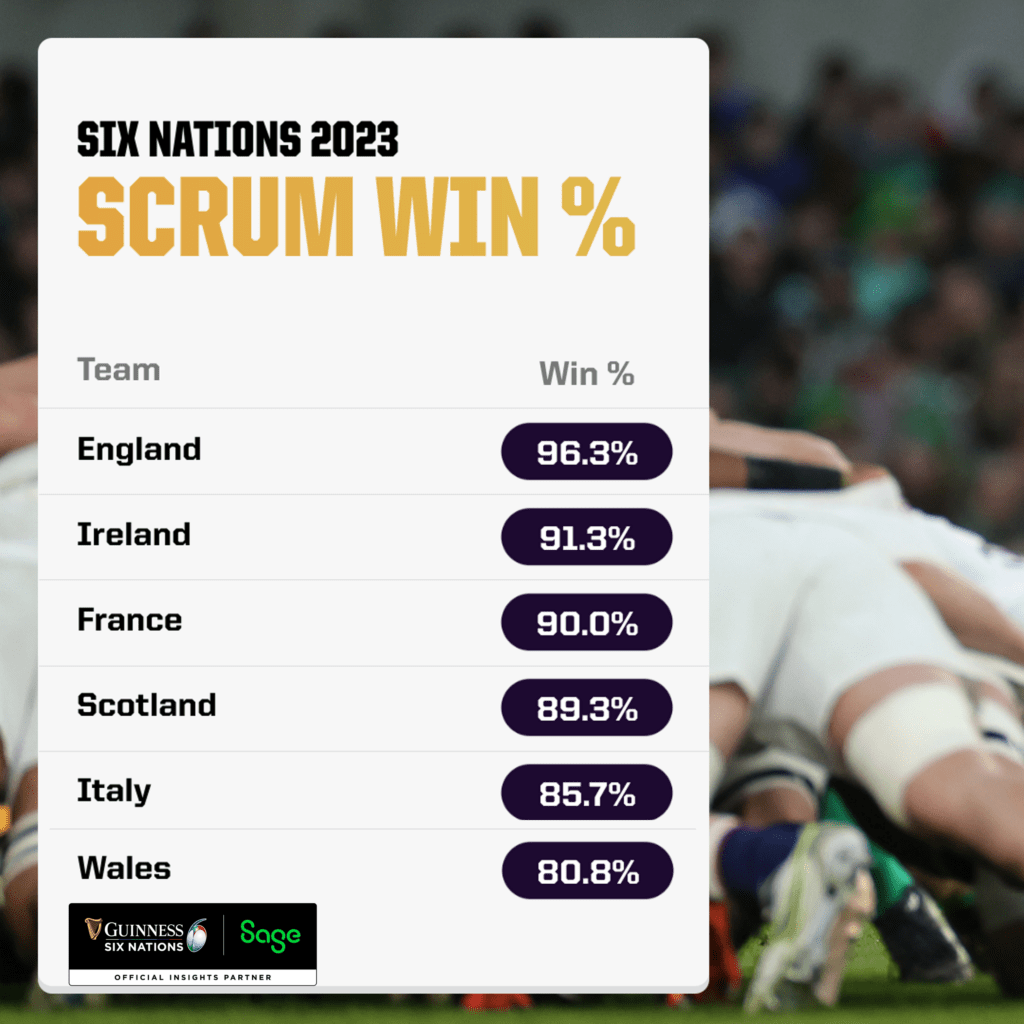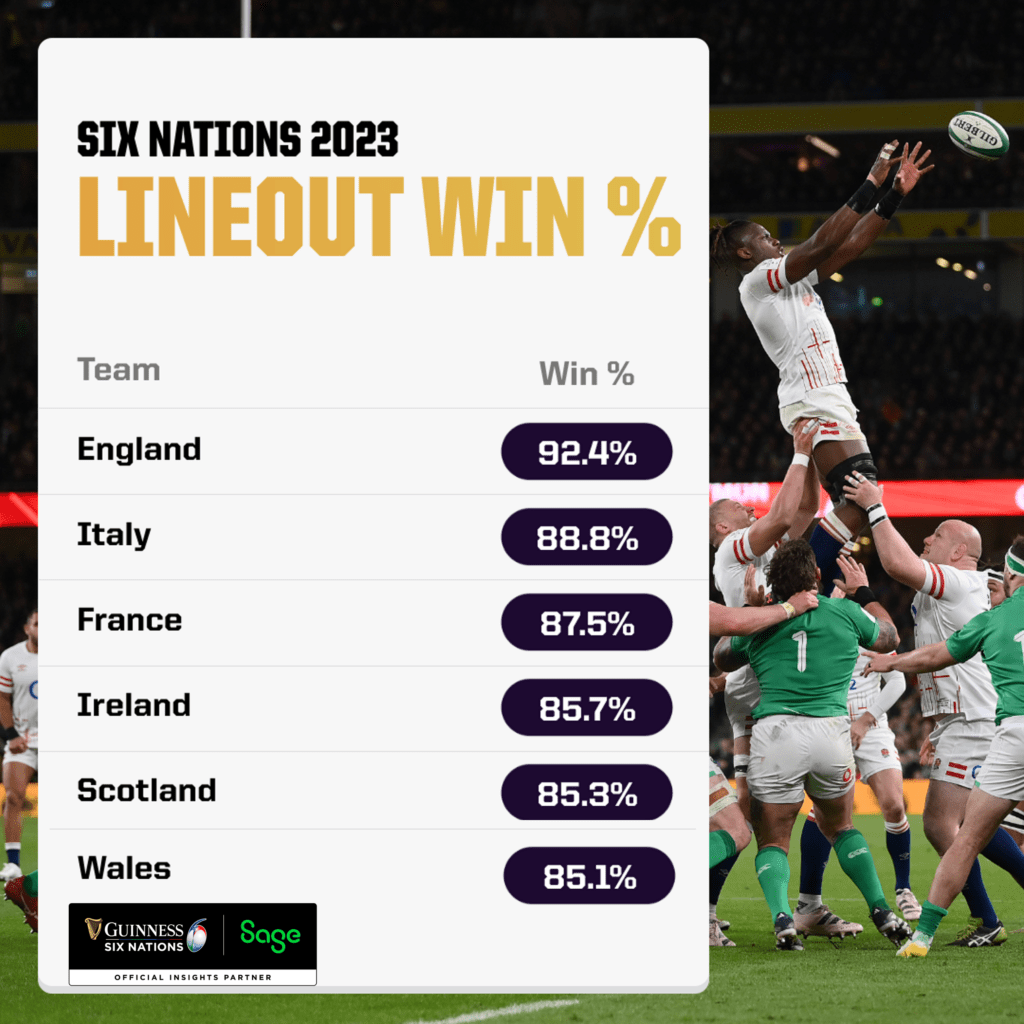The 2023 Six Nations came to a thrilling conclusion at the weekend, with Ireland completing the Grand Slam and Johnny Sexton surpassing former team-mate Ronan O’Gara as the all-time top scorer in the Championship’s history. Elsewhere, Italy pushed Scotland to the wire in Edinburgh while Wales gave fans some cause for optimism with a late flourish against the French, who were at their brilliant best once again.
The OptaJonny team dive into the data behind each match and assess the performances of each nation overall in 2023…
Scotland 26-14 Italy
Scotland overcame the Azzurri in a match which was a lot nervier for Gregor Townsend and his side than the scoreline might suggest. With Scotland just five points up and Italy camped deep in opposition territory there was a sense that Kieran Crowley’s side might just repeat their heroics of last year when they stole victory against Wales in Round Five. However, it was not to be as Scotland eventually won possession and made one last try-scoring attack to break Italian hearts.
In a fairly even game, it was Scotland’s ability to punish Italy in the Red Zone that separated the sides – both teams made nine 22 entries, however Italy managed to take 0.9 points per entry on average, compared to 2.9 for Scotland. Although the Azzurri could be criticised for their profligacy, a lot of the credit must go to Scotland who have been one of the best sides defensively in the tournament. They recorded a 95% tackle success rate in this fixture, making it difficult for Italy to create many clear-cut try-scoring chances.
While Blair Kinghorn stole the show with a hat-trick of tries, Duhan van der Merwe once against caused havoc in attack, beating eight defenders at BT Murrayfield to take his tally to 35 for the campaign, a new record for a single edition of the Six Nations. It surpassed the previous best of 31 which the Scotland winger himself set just two years ago.

France 41-28 Wales
France finished off their Six Nations in style with a comfortable victory against Wales. Warren Gatland will have felt some optimism with how his Wales side created some problems for France in the second half, showing signs that their attack may just be beginning to click ahead of the World Cup later this year.
However, France at times were irresistible, and when they carved Wales open, they had the composure to put the finishing touches on their line breaks to convert them into five-pointers. France made six line breaks during the match, only two more than Wales, but they scored from four of those line breaks – a 67% conversion rate, the best of any side at the weekend. France have always had the ability to cut through teams, but under the watchful eye of Fabien Galthié, they have developed a real killer instinct to punish teams when they break the defensive line.
Ireland 29-16 England
A nervy Ireland had a shaky start to their Grand-Slam deciding match against England but steadied the ship late on in the first half through a Dan Sheehan try before a Freddie Steward red card on the stroke of half-time dampened England’s hopes of spoiling the Irish party.
Ireland were hot favourites going into the match, as one might expect for a side chasing a Grand Slam against a team who suffered one of their worst-ever defeats one week previously. However, England came out fighting in the first half, their aggressive defence forcing uncharacteristic errors from Ireland as they moved into a 6-0 lead after 15 minutes. At that point, England’s chances of winning the match peaked at 39% according to Opta’s Live Win Probability model, although they would remain at a similar level until the final 10 minutes of the first half when Ireland crossed for the opening try to take the lead before England were reduced to 14 men.

Despite the result, England’s first-half performance will have gone some way to restoring some pride for Owen Farrell and his side, although it was ultimately Farrell senior who was celebrating come full time, as his Ireland team secured one of the most dominant Grand Slams in the Six Nations era. It was fitting too, that talisman and captain Johnny Sexton also set a new point-scoring record in the Championship, with his nine points taking him to 566 in the Six Nations overall, surpassing former team-mate Ronan O’Gara (557) as the all-time top point scorer in Five/Six Nations history.

What We Learned
After an incredible Championship, let’s not dwell on any of the negatives. Instead, let’s look at the positives for each team after five rounds of action, assessing where their strengths might lie as the Northern Hemisphere shifts its collective focus onto this year’s Rugby World Cup.
England
Steve Borthwick’s first campaign as England Head Coach was a mixed bag, however he will have certainly seen signs of his team moving in the right direction this campaign, and even the France result – as embarrassing as it was – might be viewed as a necessary learning experience for this side further down the road.
Borthwick’s Leicester team built their foundations upon a strong set piece and that was perhaps the biggest improvement in England’s game this year. They topped the charts for both lineout and scrum success rate in 2023 and at the scrum they weren’t just solid – it also showed signs of being a potential weapon for them, winning four penalties on the opposition feed, twice as many as any other team managed.
After winning their lineouts, England also gained the most metres from their maul (73) while their three tries directly from mauls were also more than any team. England didn’t just win the set-piece battle, they were able to punish teams on the scoreboard with it too.


France
Les Bleus showed us just how clinical they can be in attack during this year’s Six Nations, a stark warning to the nations on their side of the draw for this year’s Rugby World Cup. France made 34 line breaks in the 2023 Six Nations, a tally only Ireland could better, but it was the way in which they were able to turn those line breaks into tries which caught the eye in the Championship this year. France scored 17 tries following a line break, meaning that every other break they made ended in a five-pointer, with their 50% conversion rate being the best of any nation this year.

That also translated into incredibly positive 22-entry numbers as they averaged three points per entry, the most of any team, and with only Ireland making more entries overall it meant a lethal combination for Fabien Galthié’s side.
Ireland
‘Attack wins games and defence wins titles’, is how the saying goes but in Ireland’s case they had a combination of both as they steamrolled their way to Grand Slam glory. Ireland averaged the most carries per game, gaining the most metres and making the most line breaks in the process, while they dominated the breakdown too – their 97% ruck success was the best of any nation and only Italy managed to record a quicker ruck speed than Andy Farrell’s side (3.2s).
In defence, Ireland conceded the fewest points per 22 entry (1.2) with only England allowing teams into their 22 less often overall. That was largely helped by the fact that Ireland won more turnovers than any other side, stopping their opponents from being able to pile on pressure.
Ireland were incredibly disciplined too, conceding the fewest penalties of any team and being the only nation not to be shown a card of any colour.

Italy
Although Italy ended their campaign with a Wooden Spoon once again, this felt slightly different than previous years. The Azzurri couldn’t quite end their campaign with victory like they managed last year, but arguably this was a more positive Six Nations aside from results.
Kieran Crowley has turned Italy into a wonderfully expansive team capable of causing damage to teams out wide – a far cry from the Azzurri of old which was heavily reliant on a dominant set piece. Italy averaged the most passes per game of any nation this year (195) but there was a real purpose in the way they moved the ball. As a result, Italy moved the ball beyond the first receiver more often than any other side in the Six Nations this year, doing so from 35% of their rucks, with 60% of their phases seeing the ball move at least 10 metres wider than the previous breakdown – another Championship high.
Moving the ball wide can bring danger not only to the opposition but also to yourself, with the outside backs being more vulnerable at the breakdown. But Italy’s work in this area was much improved and they even managed to record an average ruck speed of 3.0 seconds, the best rate of any team.
Italy have one of the toughest pools in this year’s World Cup, but they will back themselves to give France and New Zealand some headaches come September.
Scotland
Scotland have now recorded three wins in five of the last seven editions of the Six Nations, after doing so just once in their initial 17 campaigns. During those seven years, Scottish expectation has rightly risen but it was this year that brought the first genuine hopes of a Triple Crown, or even a Six Nations title.
Scotland have serious flair in attack: their back line is led by Finn Russell but they have incredible balance throughout numbers 9-15, mixing fluid attack with sturdy defence.
Scotland caused problems for many teams out wide, moving the ball 20 metres wide of the breakdown on 14% of their phases – a Championship high. However, it is their defence that makes them so difficult to beat. Scotland missed just 75 tackles – every other nation saw their missed tackle numbers go into triple figures – and were the only team with a tackle success rate of 90% or better (92%). However, it wasn’t just their first up defence that was impressive; from their 75 missed tackles, 81% saw the attacking team stopped before being able to break the line or score a try, again the best such rate of any team. Shaun Edwards might be the yardstick against whom defence coaches are rated but Steve Tandy and his Scotland defence are rapidly approaching the same heights.
Wales
Wales endured a turbulent campaign but there were reasons for optimism for the team and fans alike. After opening 2023 with three defeats, Warren Gatland’s side got back to winning ways in clinical fashion in Rome, before ending the Six Nations with a flourish and securing a try bonus point in Paris, albeit in defeat.
Wales’ kick chase has always been a strength and this year was no different. Not only did Wales regather possession from their kicks more often than any other team (21), but they also did so at the highest rate with 14% of their kicks from hand being reclaimed by a man in a red shirt. That weapon is vital in Test rugby where territory doesn’t come easy, but knowing that when other attacking options have been exhausted Wales can take the aerial route with genuine hopes of holding onto possession will bring confidence to Gatland’s men.
Wales will also be pleased with how they held onto the ball during this year’s Six Nations, conceding a Championship-low 11.4 turnovers per game. While it will take time for Wales’ attack to click under a new coaching structure, it is comforting to know that they are not giving up easy possession on a regular basis.
Meanwhile, they showed great physicality in defence making 55 dominant tackles during their campaign – no side made more.
Although it was by no means a vintage year for Wales, there are some early signs that the building blocks are there for a positive Rugby World Cup campaign.
Enjoy this? Subscribe to our newsletter to receive five stories each Friday. It’s free. Also, follow us on Twitter.
